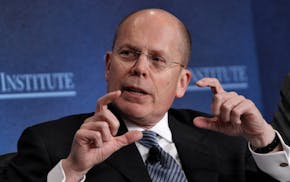A fixture in the St. Paul job training scene is closing after 60 years as the U.S. Department of Labor shifts money away from vocational centers nationwide.
The Labor Department said its analysis found the centers to be costly and, as a whole, failing to produce sufficient graduation rates.
"The department's decision aligns with the president's fiscal year 2026 budget proposal and reflects the administration's commitment to ensure federal workforce investments deliver meaningful results for both students and taxpayers," said Labor Secretary Lori Chavez-DeRemer in a statement late last week.
The department notified the St. Paul center Thursday that it had to terminate all 161 students and trade apprentices by Friday, said Katie Kapaun, the center's director.
On Saturday, the deadline was extended to June 13, but the department said the entire campus must shut down by June 30, when the center's contract will be terminated.
"We are exhausted. We're devastated. We care about these students a lot," Kapaun said.
More than 60 of the 161 students currently "don't have anywhere to go."
For now, her staff of 100, who will lose their jobs as the center shuts down, are working with Ramsey County to get the trainees into stable housing. They are also working with employment and trade union partners to secure the students' jobs.
The center's campus at 1480 Snelling Av. trained 264 students a year before the pandemic.
Now it houses and trains 161 teens and young adults in construction, electrical trades, industrial painting, certified nursing, culinary arts and office administration. Job Corps grads have gone on to work for, among others, Hilton Hotel restaurants, Delta Air Lines and the Minneapolis-St. Paul International Airport, the International Union of Painters and Allied Trades and Painting by Nakasone, Kapaun said.
Employees and state legislators called the move by the Department of Labor short-sighted.
Bobby Joe Champion, the DFLer from Minneapolis who chairs the Minnesota Senate Jobs and Economic Development Committee, slammed the budget-cutting move, noting that both Republicans and Democrats on his committee oppose the action.
The decision to cut the Job Corps program "is taking us in the exact wrong direction," said Champion in an email Tuesday. "It is extremely disheartening to see the Trump administration negatively impact so many young lives in this way."
The Labor Department said it is working with state and local workforce partners to connect students with other education and employment opportunities.
While "our in-depth fiscal analysis reveal the program is no longer achieving the intended outcomes that students deserve, we remain committed to ensuring all participants are supported through this transition and connected with the resources they need to succeed as we evaluate the program's possibilities," Chavez-DeRemer said.
In fiscal year 2024, the program operated at a $140 million deficit, requiring a pause of operations that year, the Labor Department said. The deficit this fiscal year is projected to reach $213 million.
Chavez-DeRemer added that all federally supported job corps centers were targeted for cuts after a first-time report analyzed 2023 data and found "a startling" 1,764 incidences of violence. The report said that all job corps centers averaged only a 39% high school graduation rate and that the jobs received by student participants sometimes paid just $16 an hour.
The data in the report showed that the Hubert H. Humphrey Job Corps program had better financial outcomes than many others. In 2023, the program helped 216 teenagers at a cost of $9.9 million total, or $63,683 per enrollee.
It also said graduates were placed in apprenticeships and jobs paying just $20,759 a year. While better than the average, the report said the St. Paul center's graduation rate was just 47%.
"That's not accurate," Kapaun said, noting that her St. Paul graduation rate was 63% and that apprentices placed in jobs earned an average $19.82 an hour with dozens of construction and painting trainees earning $28.60 an hour plus benefits worth much more.
She also noted that average annual wages exceed more than $30,800, according to the National Job Corps Association.
"And we don't have violence on our campuses. We have a zero tolerance policy. So we don't have violence. We are very safe," Kapaun said.
She believes Labor Department officials misconstrued COVID-era data when the center had to pause operations, as well as other incidences when the center reported power outages, jobsite injuries and any time a student had to see a doctor.
By law "we have to report everything," Kapaun said. "For every dollar you put into a Job Corps student, you get $1.15 back in return on investment. That's really important. The work we do matters and our students matter. And we hope that we get an opportunity to continue this work."
Lindsey Port, the DFLer from Burnsville who chairs the Minnesota Senate Housing Committee, said the action could cause student participants to face homelessness.
"The U.S. Senate has the power to stop this; they must vote no on Trump's unconscionable budget," Port said in an email.

Prices for international flights drop as major airlines navigate choppy economic climate
Minnesota's med spa industry rises in popularity — and with little regulation

Hundreds line up at Best Buy to nab Nintendo Switch 2, in scene like '90s opening parties
